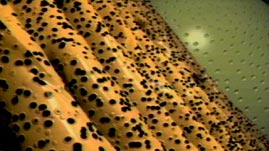Teachers' Domain - Digital Media for the Classroom and Professional Development
User: Preview

Source: Carolina Biological Supply Company, An Introduction to the Living Cell
For the longest time, scientists couldn't imagine how simple cells managed to perform so many amazing tasks in living organisms. It turns out that cells aren't simple at all. Much like complex organisms with organs that perform specific tasks, cells have many organelles that keep them functioning properly. Explore some of a cell's most important structures in this video segment from An Introduction to the Living Cell.
Much like the organs in your body, the organelles found inside each cell perform their own specialized functions that keep the parent cell running properly. Although most cells have many types of organelles, a cell's role in part determines the type and number of its organelles. For example, a cell that is heavily involved in protein synthesis will possess large numbers of protein-synthesizing ribosomes and an extensive endoplasmic reticulum, the organelle that provides storage and transport for large molecules. Likewise, a cell that does a lot of work, like a muscle cell, will have many mitochondria to keep up with its high energy demands.
Although all of the organelles serve critical functions, one organelle -- the nucleus -- is arguably the most important for many cells. This structure contains a cell's genetic material, its DNA. DNA provides the instructions for building proteins and, thus, dictates the structure and function of the cell throughout its life. More importantly, the DNA also provides a mechanism for passing genetic information on to the next generation of cells. Through mitosis, cells replicate their DNA and then pass these complete sets of genetic material to their daughter cells when they divide.
As previously mentioned, mitochondria provide cells with energy, and because of this they are often referred to as the "power stations" of cells. The energy mitochondria produce comes from a process called aerobic respiration, in which they burn food molecules in the presence of oxygen, and release the chemical energy the food contains.
Other organelles include ribosomes, which synthesize proteins; the endoplasmic reticulum, which stores and transports proteins and other compounds within and outside the cells; Golgi bodies, which transform proteins into more complex molecules; and lysosomes, which contain as many as 40 different enzymes that the cell uses to break down large food molecules.
In addition to these organelles, which are found in most plant and animals cells, one other type is exclusive to plants: the chloroplast. Chloroplasts perform a process called photosynthesis, in which they use energy from the sun to convert carbon dioxide and water into sugars and other carbohydrates.
 Loading Standards
Loading Standards Teachers' Domain is proud to be a Pathways portal to the National Science Digital Library.
Teachers' Domain is proud to be a Pathways portal to the National Science Digital Library.
